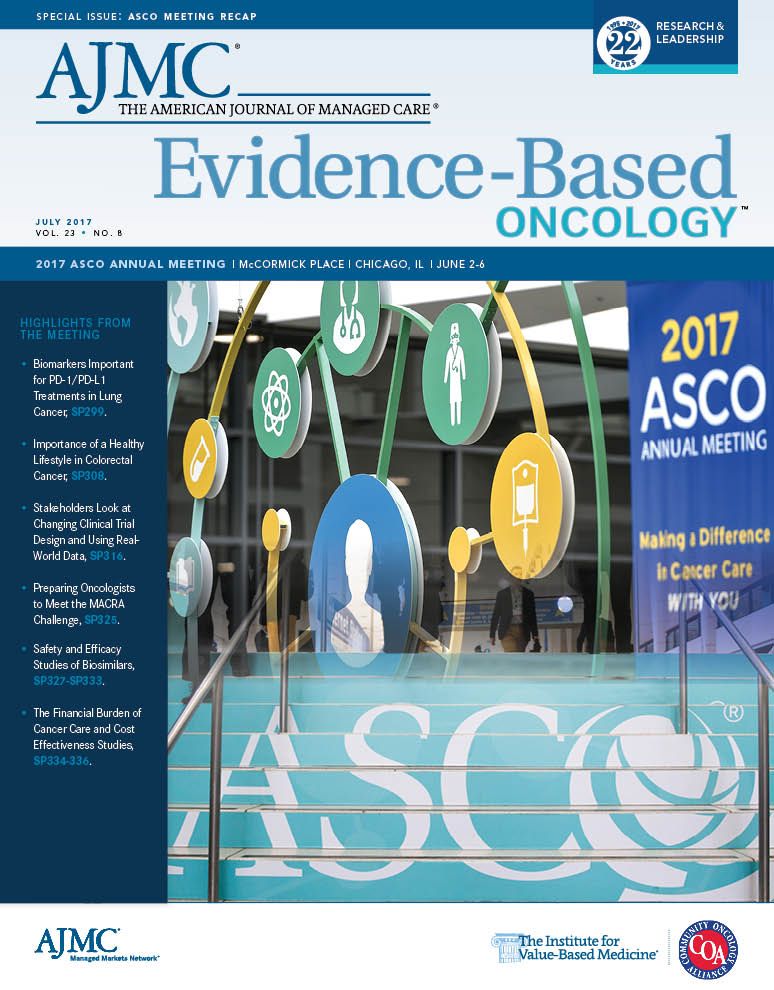Publication
Article
Evidence-Based Oncology
MACRA 2.0 and Beyond: Preparing Your Practice to Meet the Quality and Reporting Challenges
Author(s):
At the 2017 American Society of Clinical Oncology Annual Meeting, oncologists heard from fellow experts on the best way to navigate the daunting challenge of payment reform.
CMS' NEW PAYMENT MODEL,
the Medicare Access and CHIP Reauthorization Act (MACRA), is now live. MACRA, which replaced the Sustainable Growth Rate formula includes 2 tracks under the Quality Payment Program (QPP)1: the Merit-based Incentive Payment System (MIPS) and Advanced Alternative Payment Models (APMs). At the 2017 American Society of Clinical Oncology Annual Meeting, oncologists heard from fellow experts on the best way to navigate this daunting payment reform challenge.
The learning objectives of the session included the practice impact of MACRA, quality reporting and APM options under MACRA, and the impact of APMs on Medicare. Blase N. Polite, MD, MPP, associate professor of medicine, The University of Chicago, explained MIPS and APMs. “There are no fully blessed oncology payment models yet, unless you choose the 2-sided risk model offered under the Oncology Care Model (OCM).” This provided impetus for ASCO to develop its own APM, he explained.
In 2017, which is the first performance period, MIPS incorporates scores for quality, advancing care information (ACI), and improvement activities (IAs), Polite said. “Cost, unfortunately, was not included in the 2017 MIPS program score,” he added, but will find a place in the 2018 scores.
Payment, Polite explained, will be based on where a practice falls along the range of low to high performers compared with the National Median Composite Score. The 2019 scores will be based on 2017 performance. A significant chunk (60%) of the score is driven by quality reporting, formerly known as the Physician Quality Reporting Score. Although the general oncology measures set includes 19 reportable measures that comprise a mix of process and outcome measures, reporting requirements mandate only 6 measures, at least 1 of which should be an outcome or a high-priority measure, Polite said. Further, each practice is expected to report on at least 50% of patients eligible for each measure in 2017, which includes Medicare and commercially insured patients.
Explaining the cost reporting basics, Polite said that the per capita cost measures will be risk-adjusted by specialty. The measure set currently includes 41 episode measures, none of which are oncology-related. The measures include the cost of Medicare Part B drugs; Part D drugs have been excluded.
“CMS is still working with issues, such as defining an episode, and ASCO is working with CMS to provide feedback and help develop the reimbursement model,” Polite told the audience. He went on to urge the oncologists in the room to take concrete steps to work with CMS on QPP reporting, although in 2017, CMS has allowed practices to “pick their pace.” The options that are available include:
- Practices that don’t participate in the QPP reporting program in 2017 will see a negative 4% payment adjustment in 2019.
- Practices that test the program and report 1 quality measure or IA, or the required ACI measures (which, Polite said should be the least a practice should do in 2017), can avoid penalties in 2019.
- Practices involved in partial MIPS reporting in 2017—meaning they report on more than 1 quality measure or IA, or more than the required ACI—can avoid penalties and be eligible for partial positive payment adjustment in 2019.
- Practices that take on full MIPS reporting in 2017 can avoid penalties and be eligible for partial positive payment adjustment and an exceptional performance bonus in 2019.
Barbara McAneny, MD, provided a historic perspective on the evolution of payment models, comparing the top-down versus the bottom-up models, which are payer-driven and provider-driven, respectively. The provider-driven model, where the practice identifies problems that lead to changes with the way payers pay for care, is more patient-centric and geared to reduce financial toxicity for patients.
“We looked at things in our clinic that we can influence, such as hospital admission, triage to manage toxicities, and avoiding sending the patients to the emergency department (ED),” McAneny said, and that resulted in the COME HOME pilot,2 which received a CMS funding grant. Another payment model that resulted from a collaboration between McAneny’s Innovative Oncology Business Solutions and ASCO is the Patient-Centered Oncology Payment (PCOP) model. In a recent article in The American Journal of Managed Care®, McAneny and her coauthors explained that the PCOP model offers a chemotherapy or immunotherapy episode of care with 3 levels of reimbursement, leading from basic fee-for-service care to monthly payments to overall care bundles.3 A practice will get a 1-time $750 payment for each new patient, a $200 monthly fee during the 6-month episode of care, and a $50 care management payment during the active monitoring phase, which can last up to 6 months after treatment ends.
The PCOP model aims to:
- Reduce avoidable readmissions
- Ensure practices follow appropriate use criteria for drugs, tests, and imaging
- Deliver higher payments than existing reimbursement margins to participating practices
The pilot, to date, has seen:
- 11 hospitalizations (4.1% monthly hospitalization rate)
- 41 triage encounters, with 18 same-day appointments and 3 ED visits avoided
- 142 active chemotherapy months, with 92.2% pathways compliance
McAneny shared her worry with the 2-sided risk offered under the OCM. Her practice ran a simulation using 290,000 episodes from COME HOME and then randomized them. “We found that our COME HOME practice, even with all its transformations and efficiencies, has only a 3% chance of making any money.” The patient population is too small to meet the actuarial risk associated with these payment models.
“I am even concerned with taking 1-sided risk with these APMs,” she said. “We need to talk to CMS to devise a more realistic system and develop targets that we can achieve.”REFERENCES
1. MACRA. CMS website. cms.gov/Medicare/Quality-Initiatives-Patient-Assessment-Instruments/Value-Based-Programs/ MACRA-MIPS-and-APMs/MACRA-MIPS-and-APMs.html. Accessed June 5, 2017.
2. McAneny A. The future of oncology? COME HOME, the oncology medical home. Am J Manag Care. 2013;19(SP1):SP41-SP42.
3. McAneny B, Grubbs SS, Birch W, Zuckerman DS. Making sense of advanced payment models. Am J Manag Care. 2017;23(SP5):SP199-SP200.







